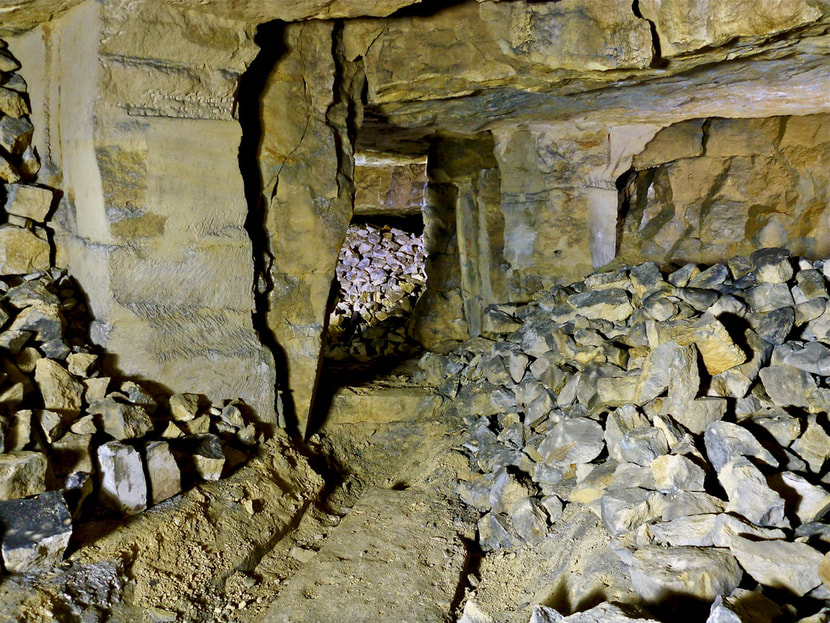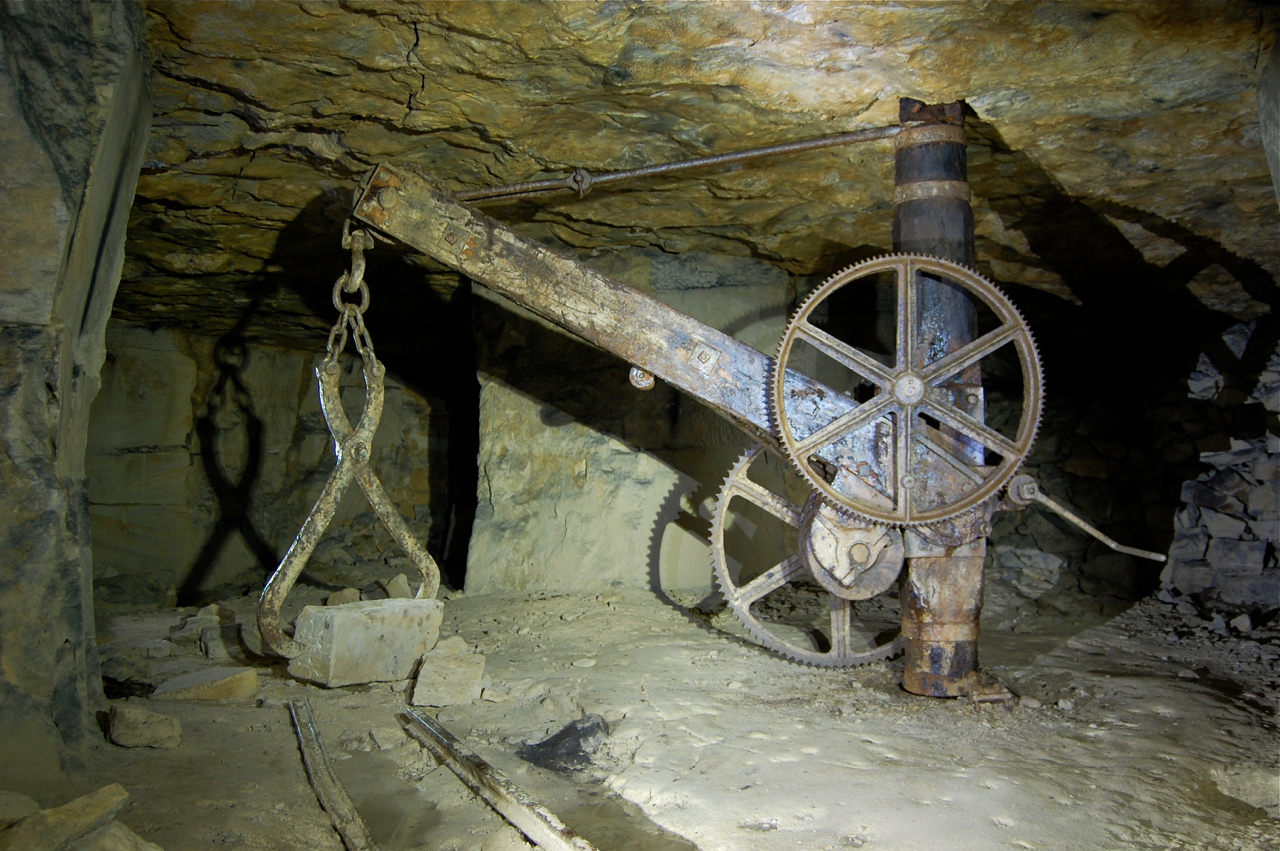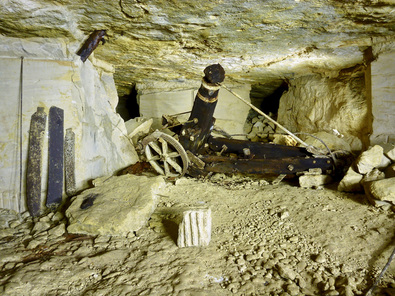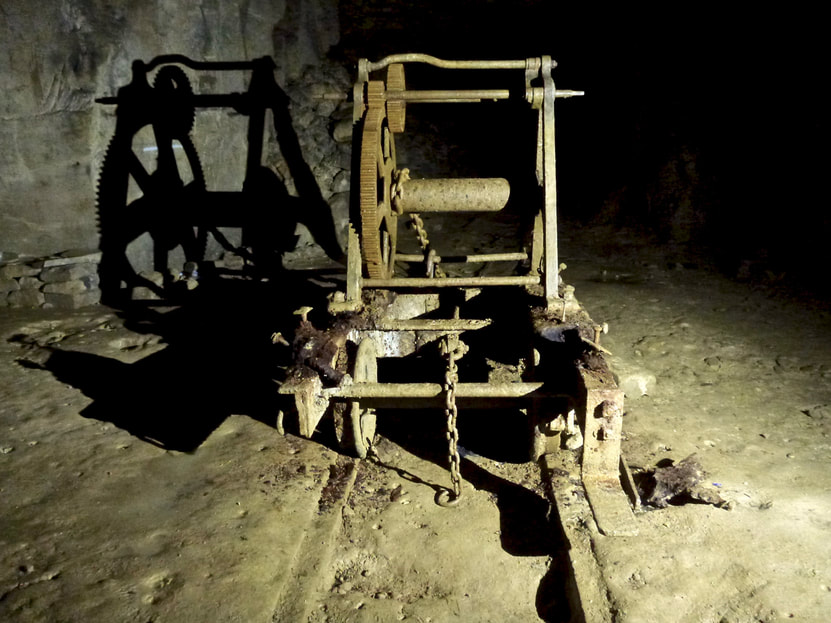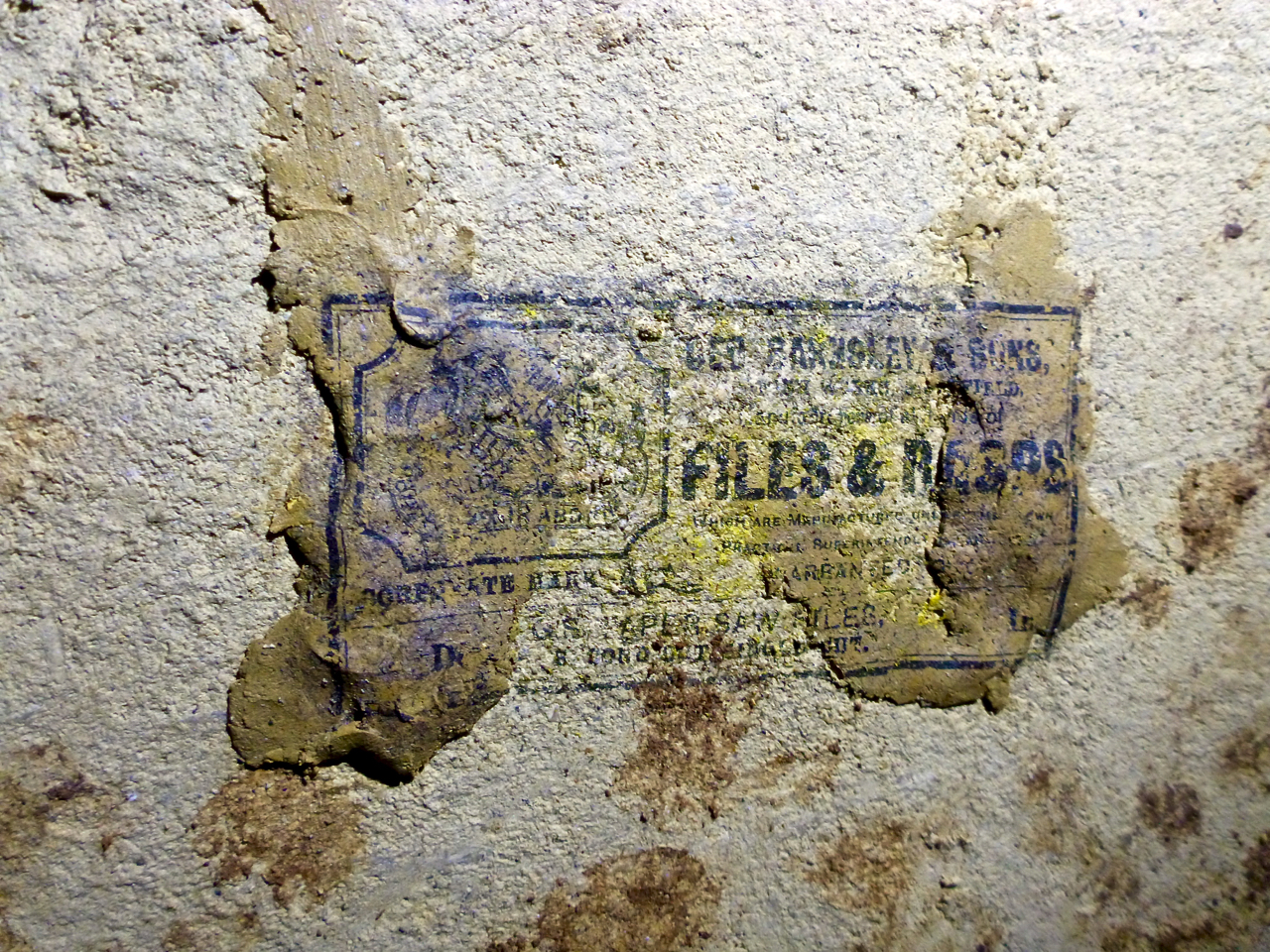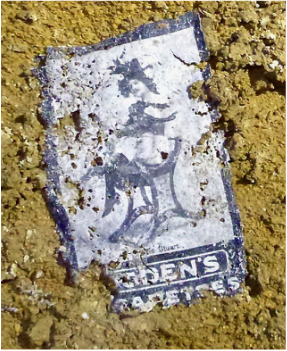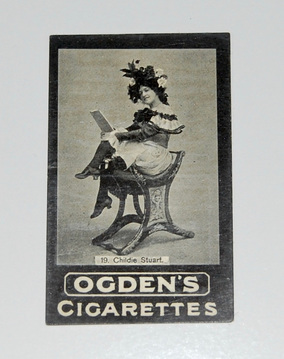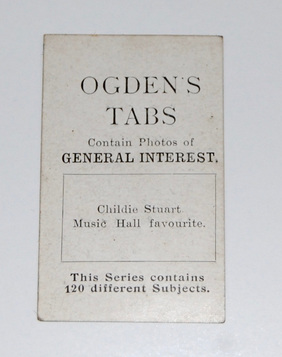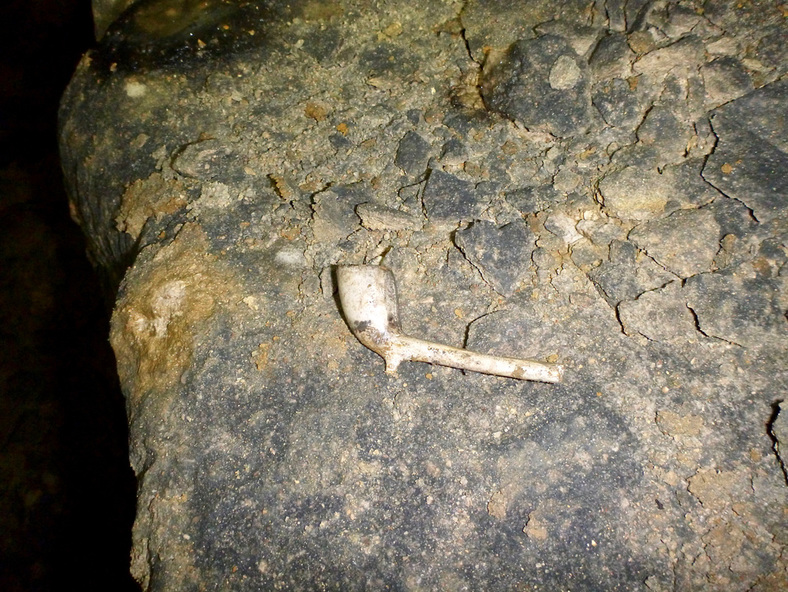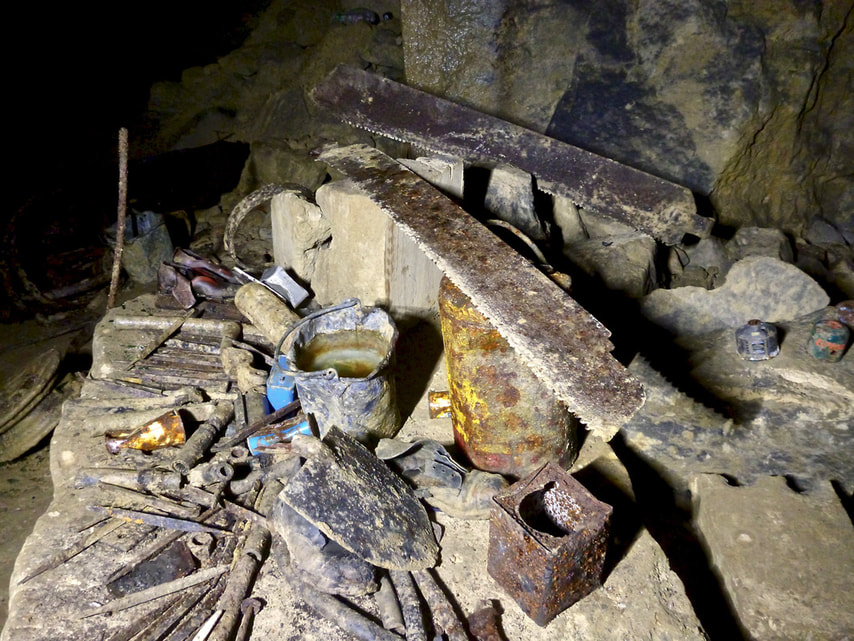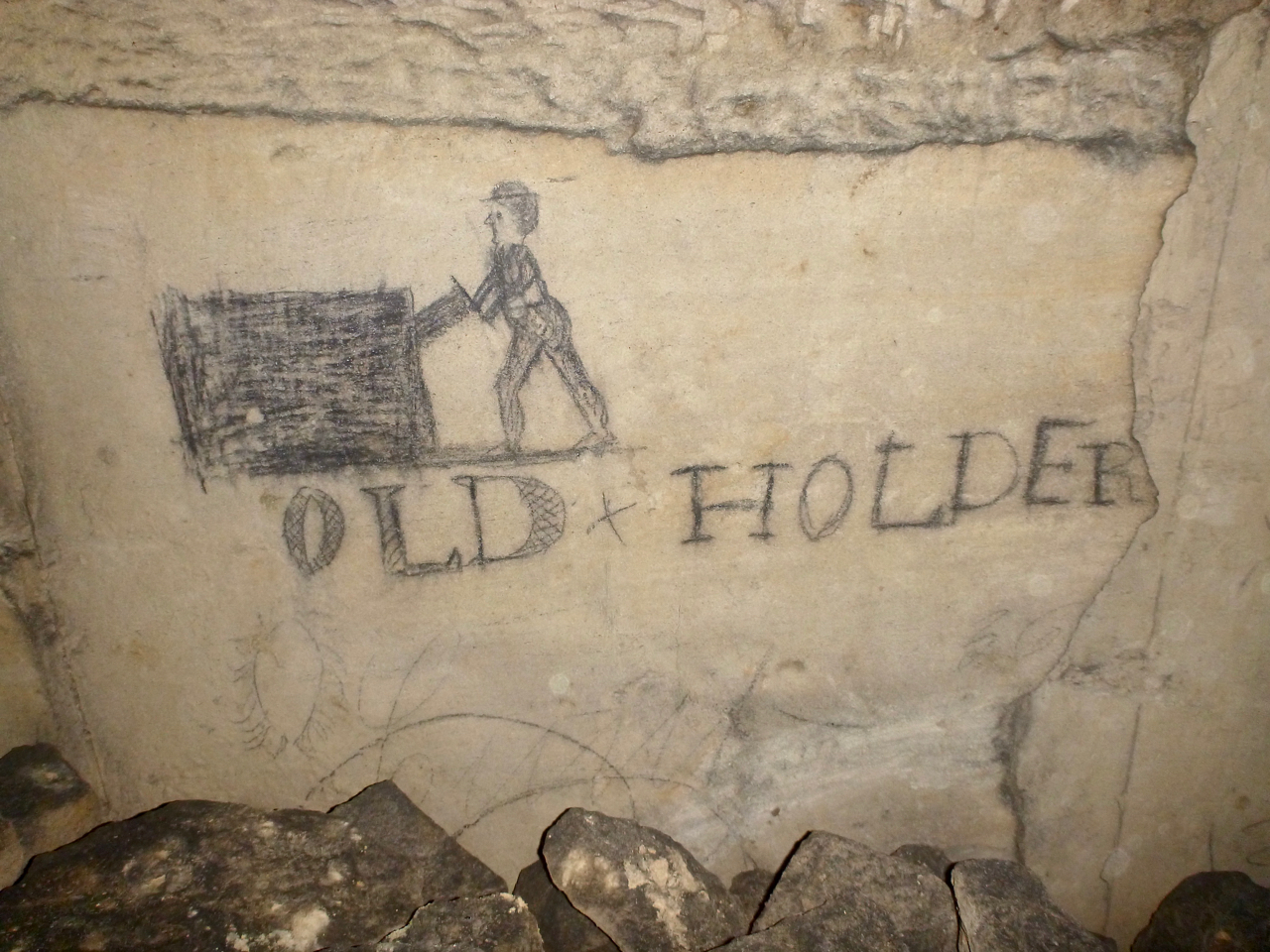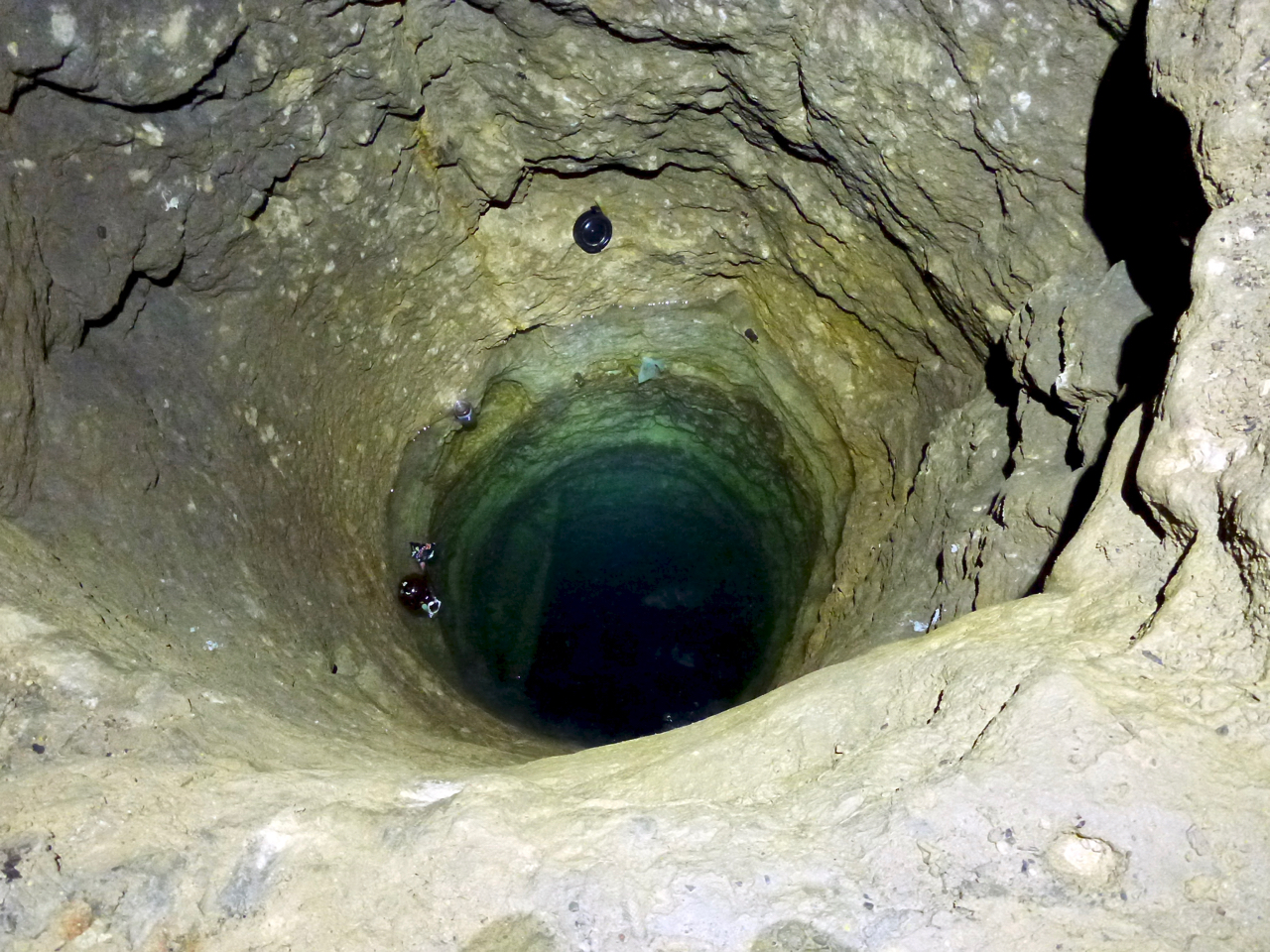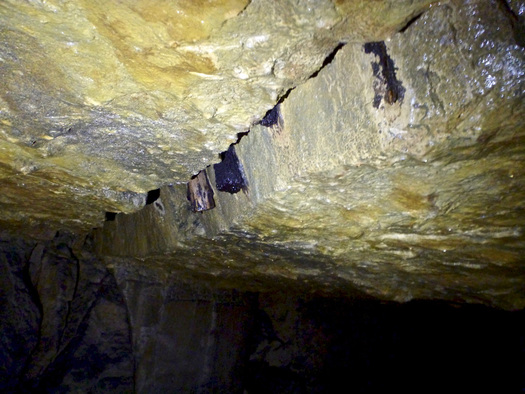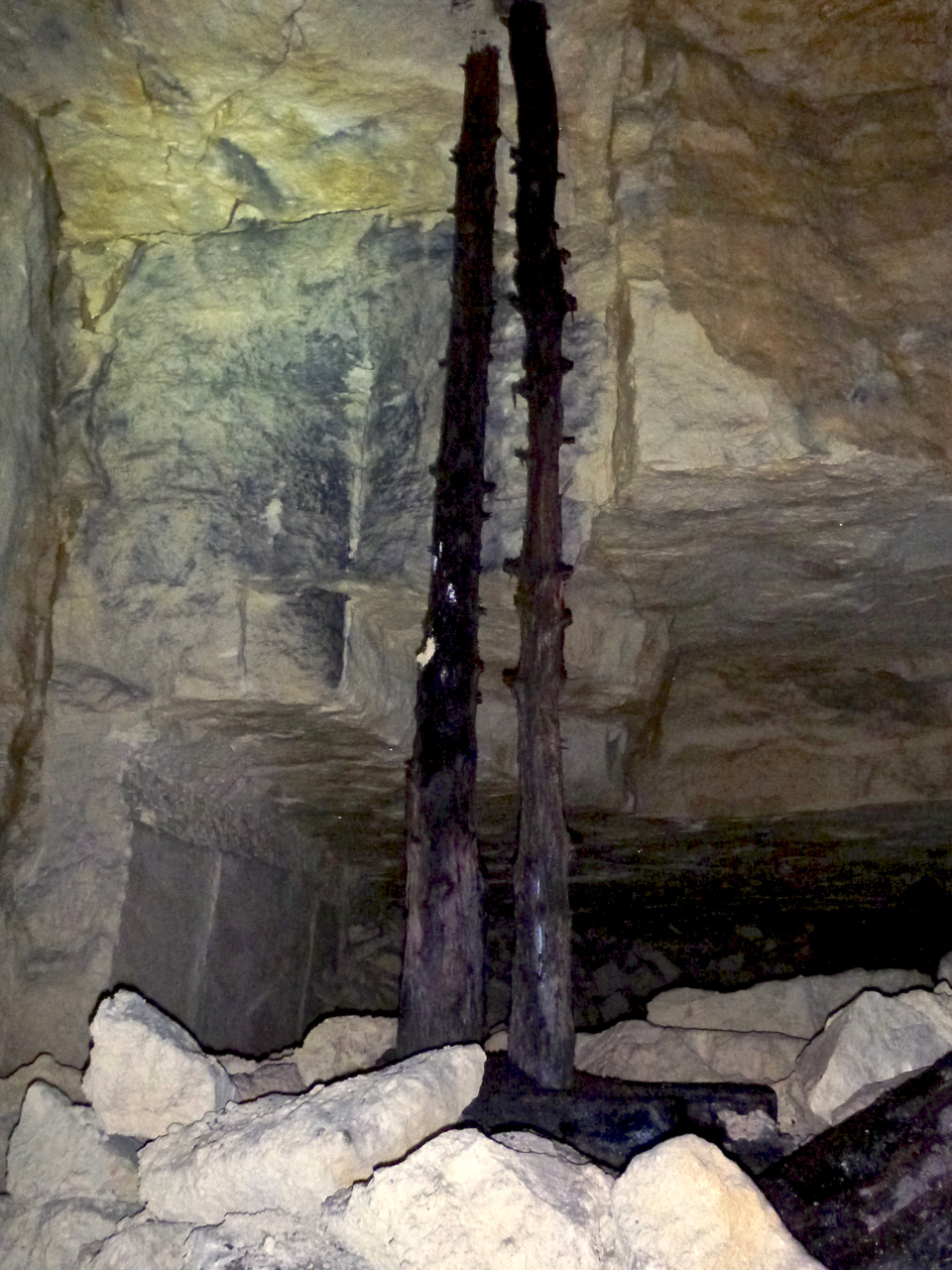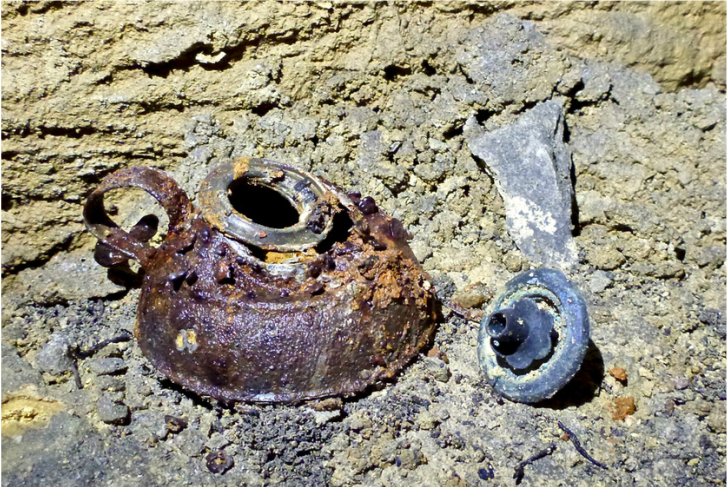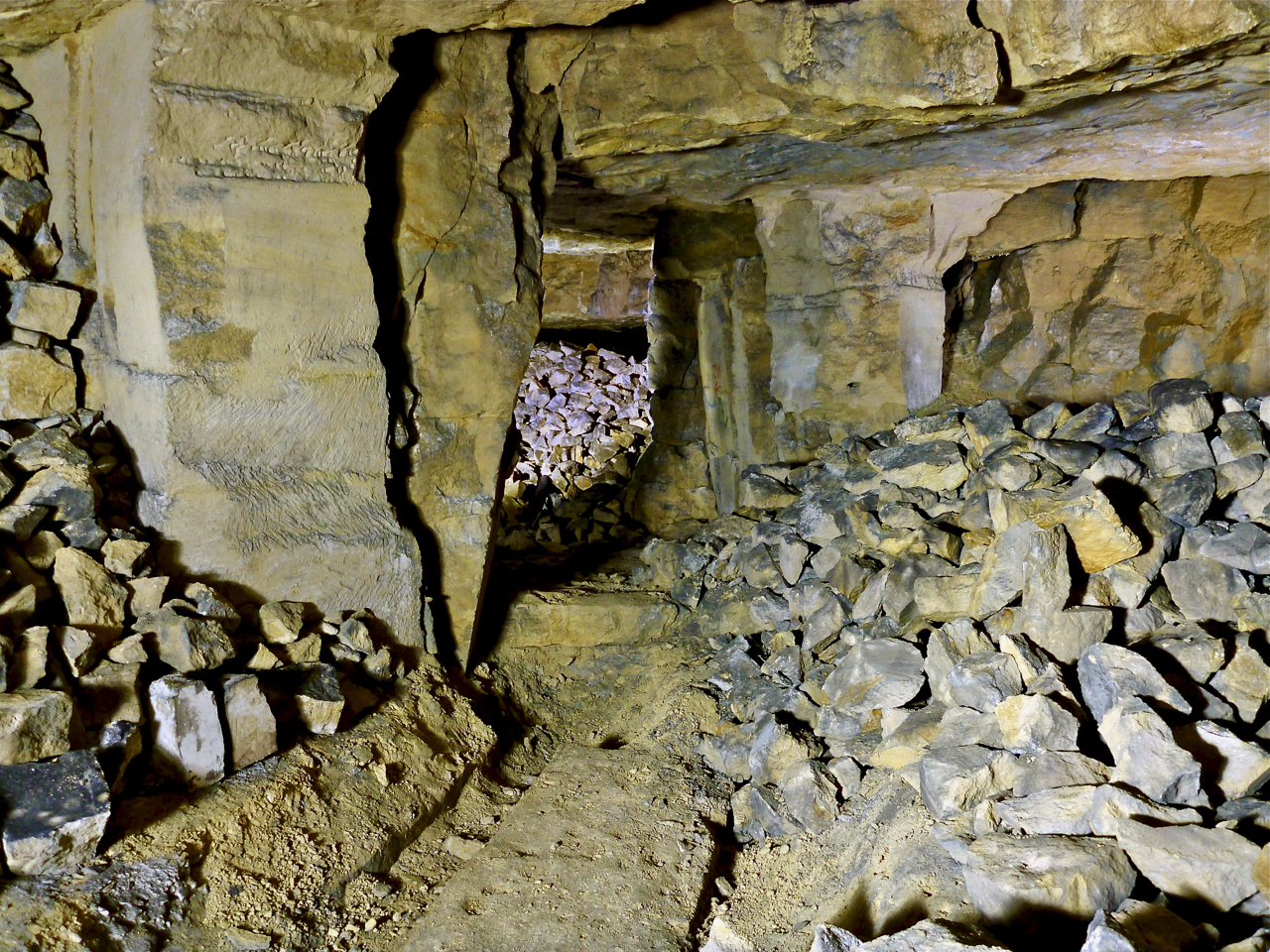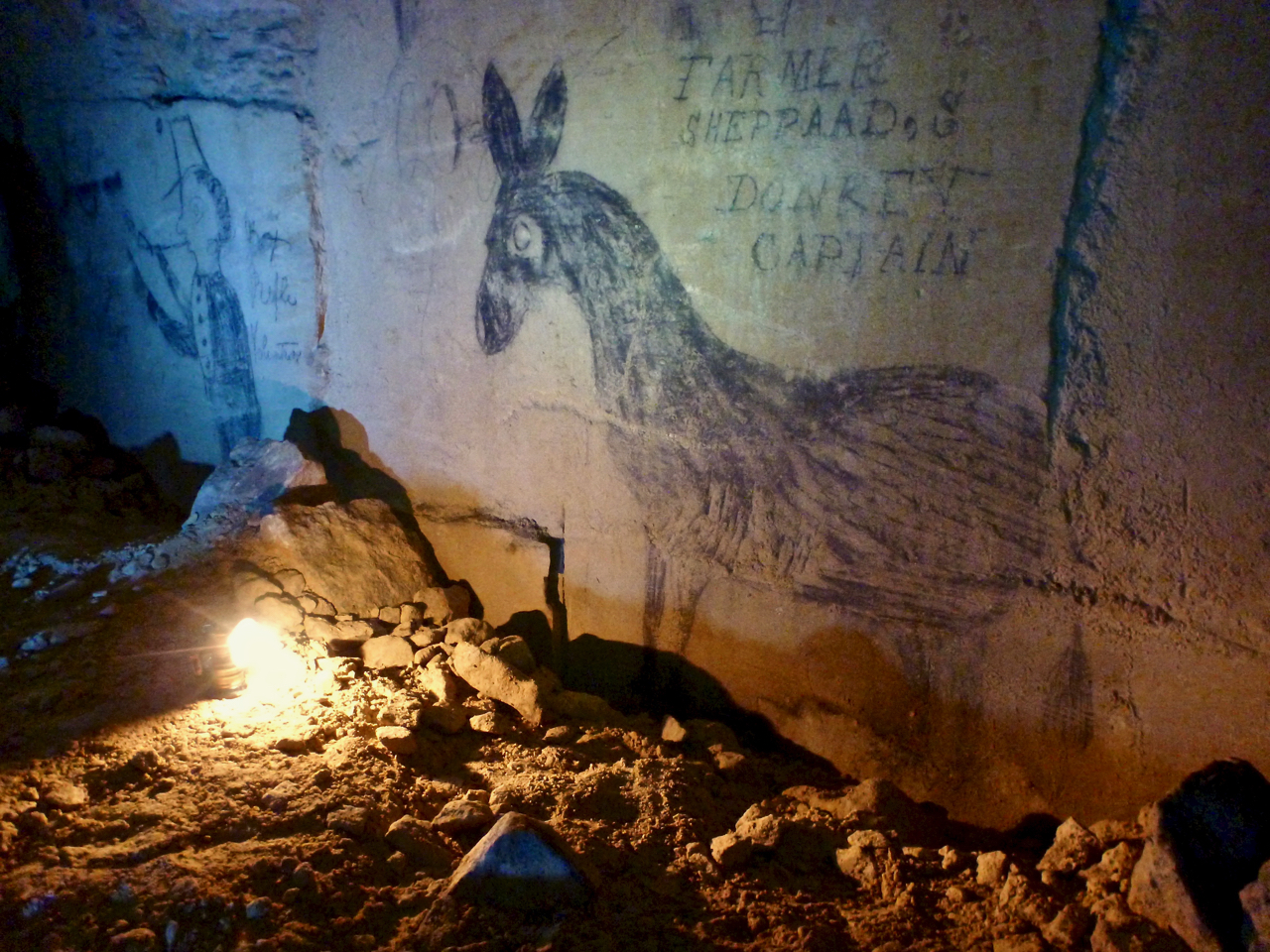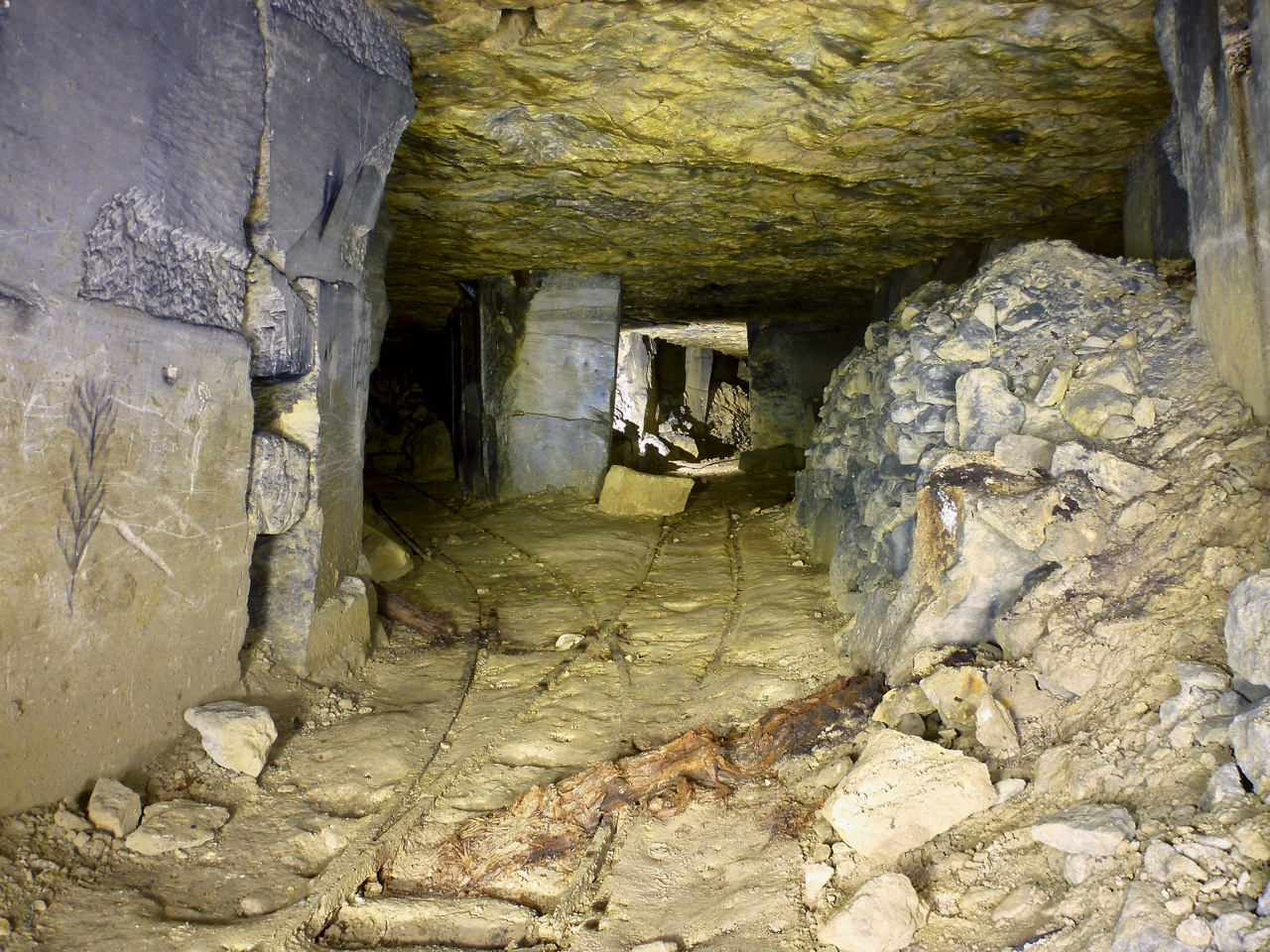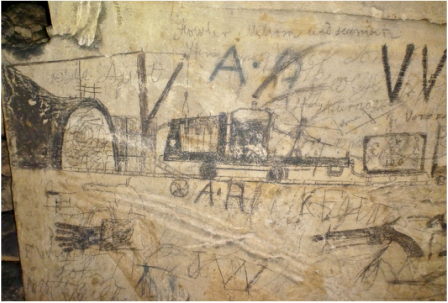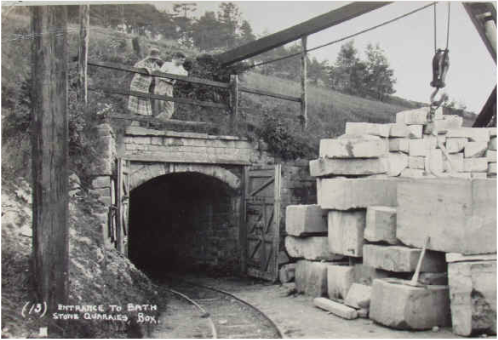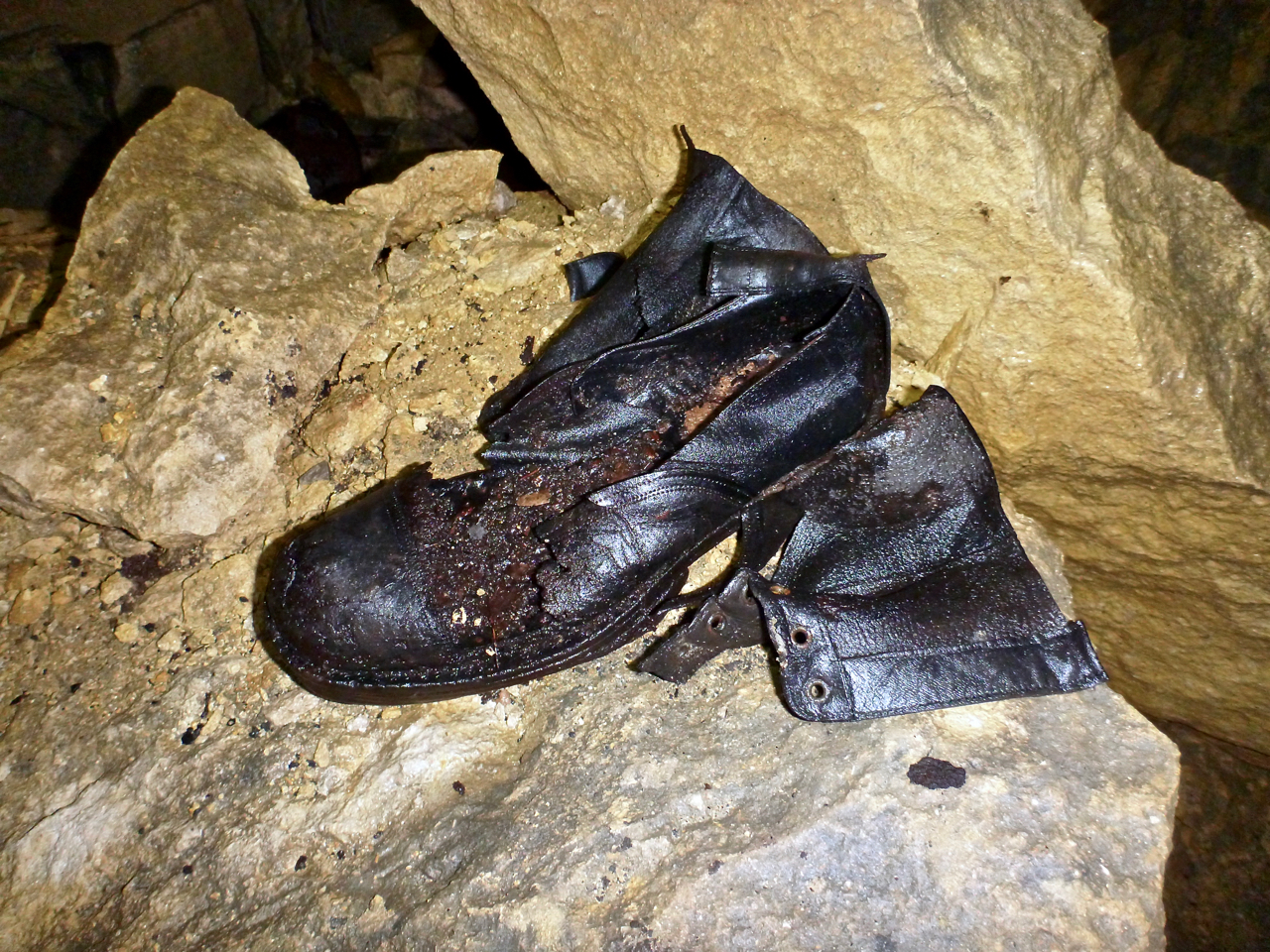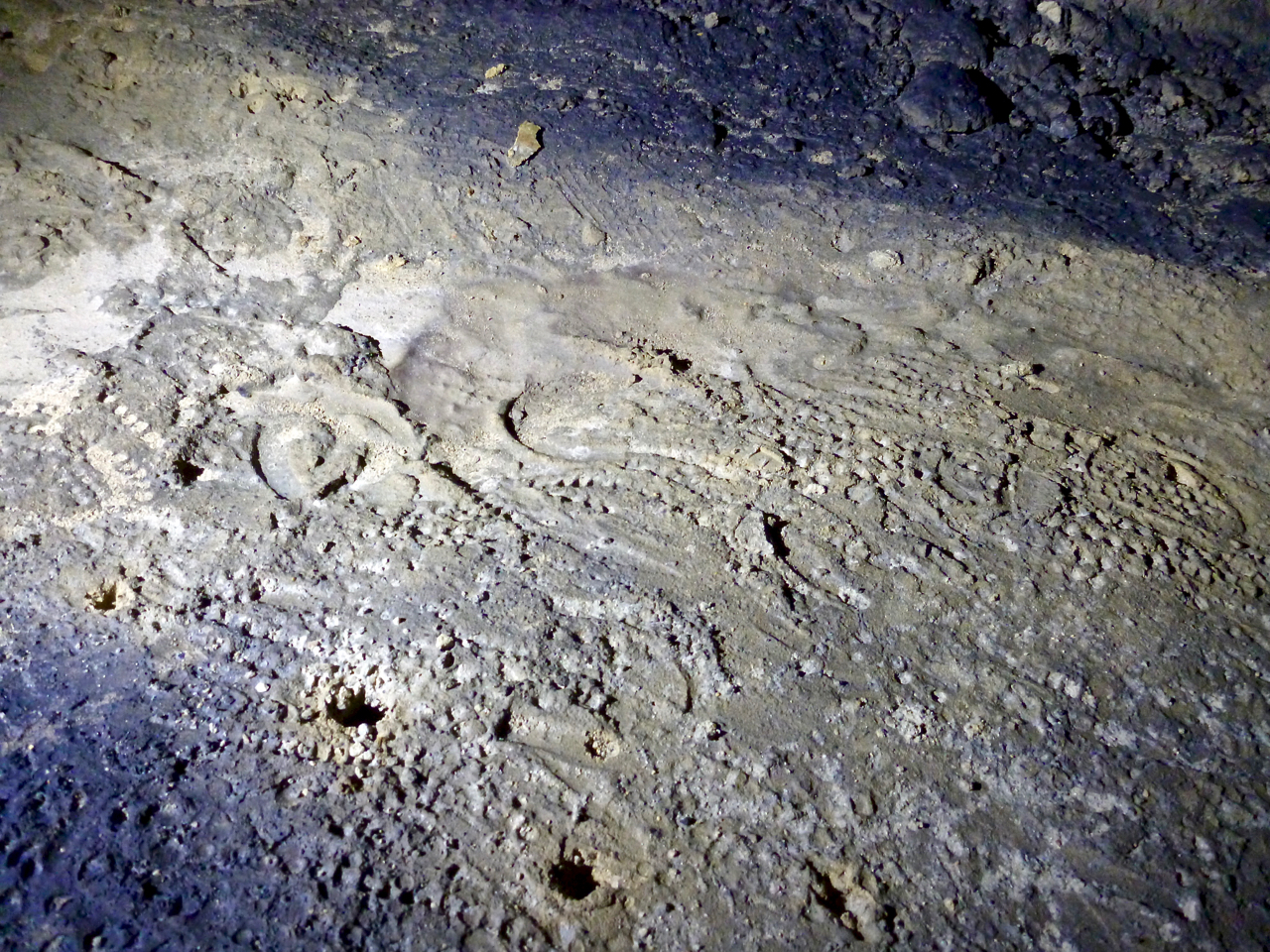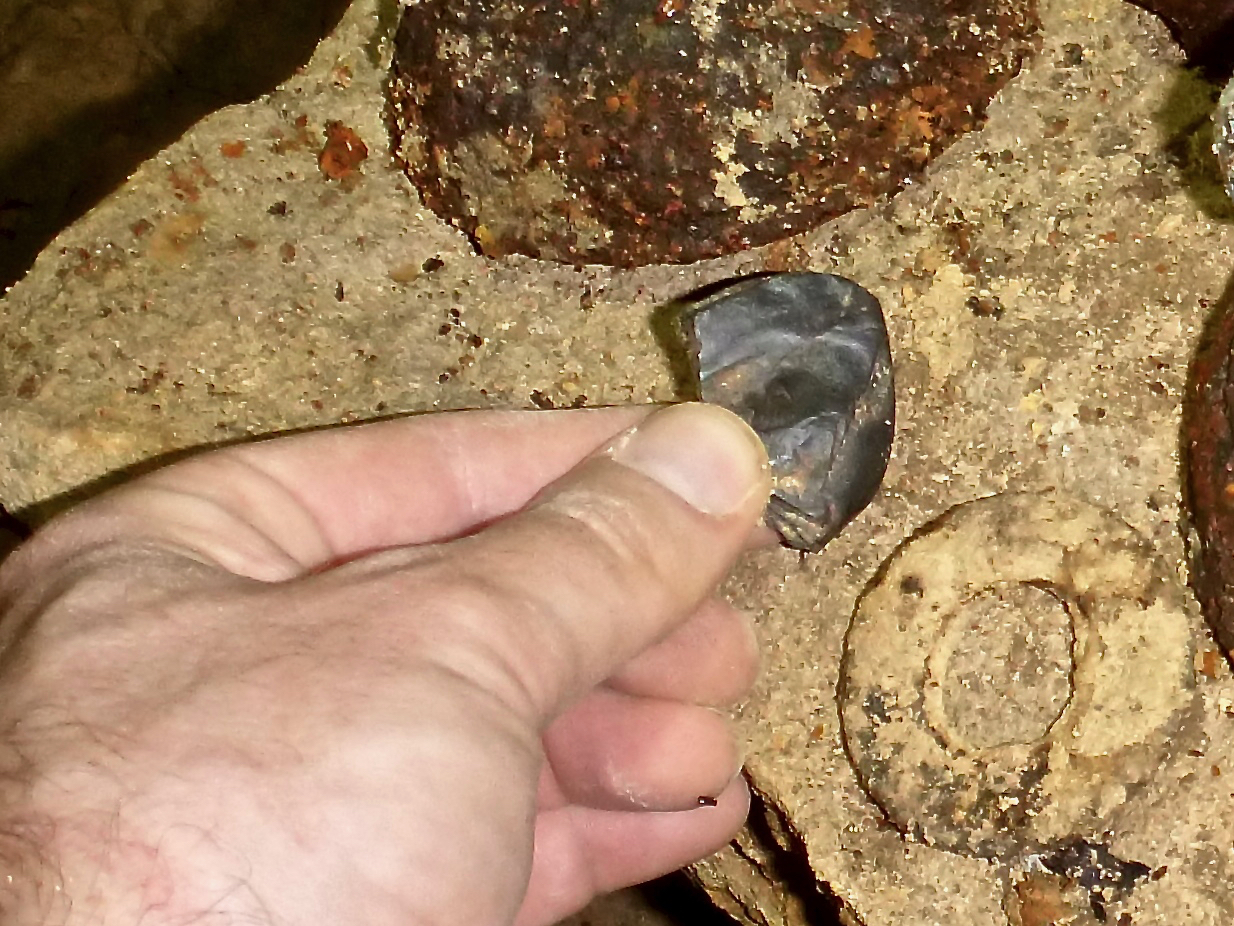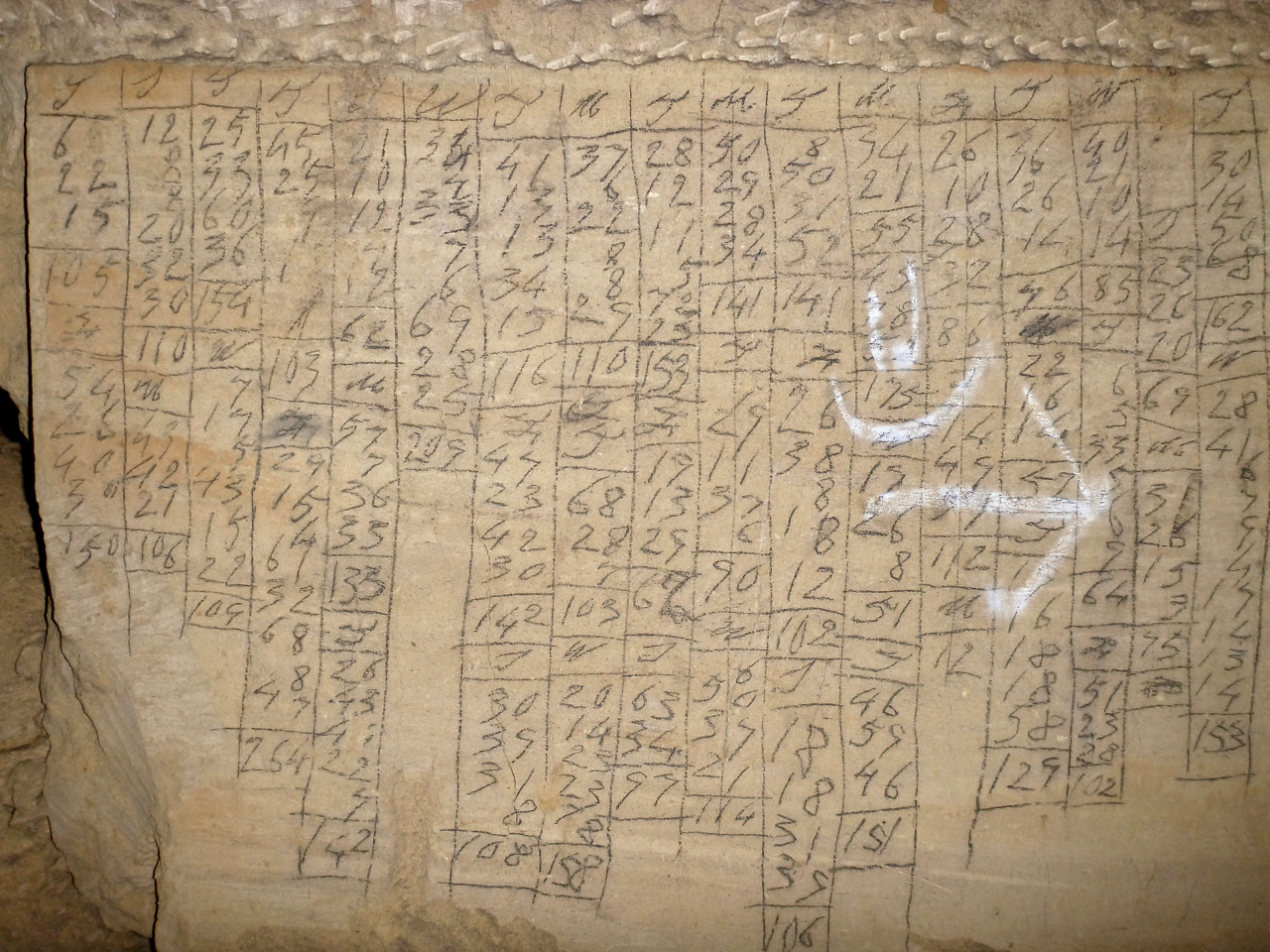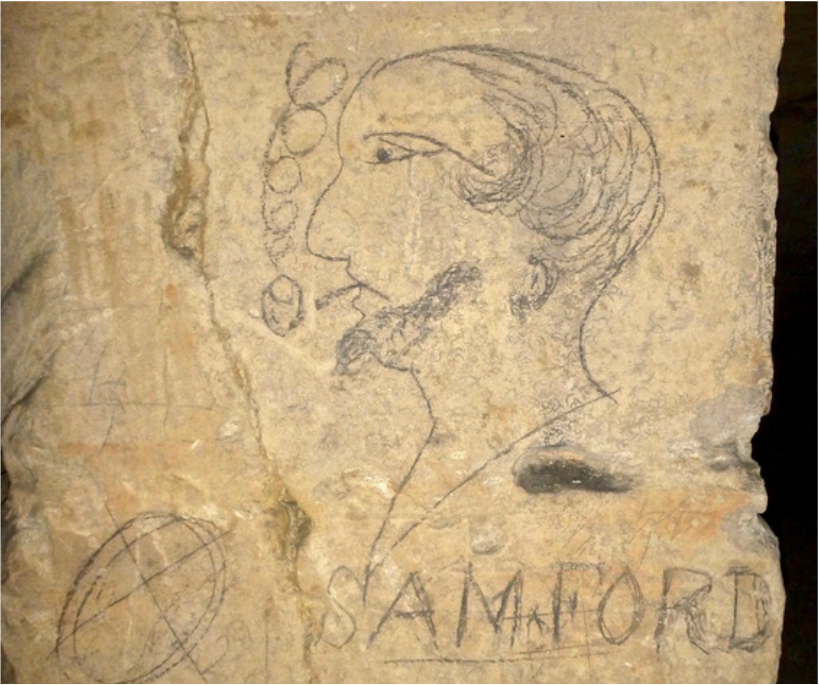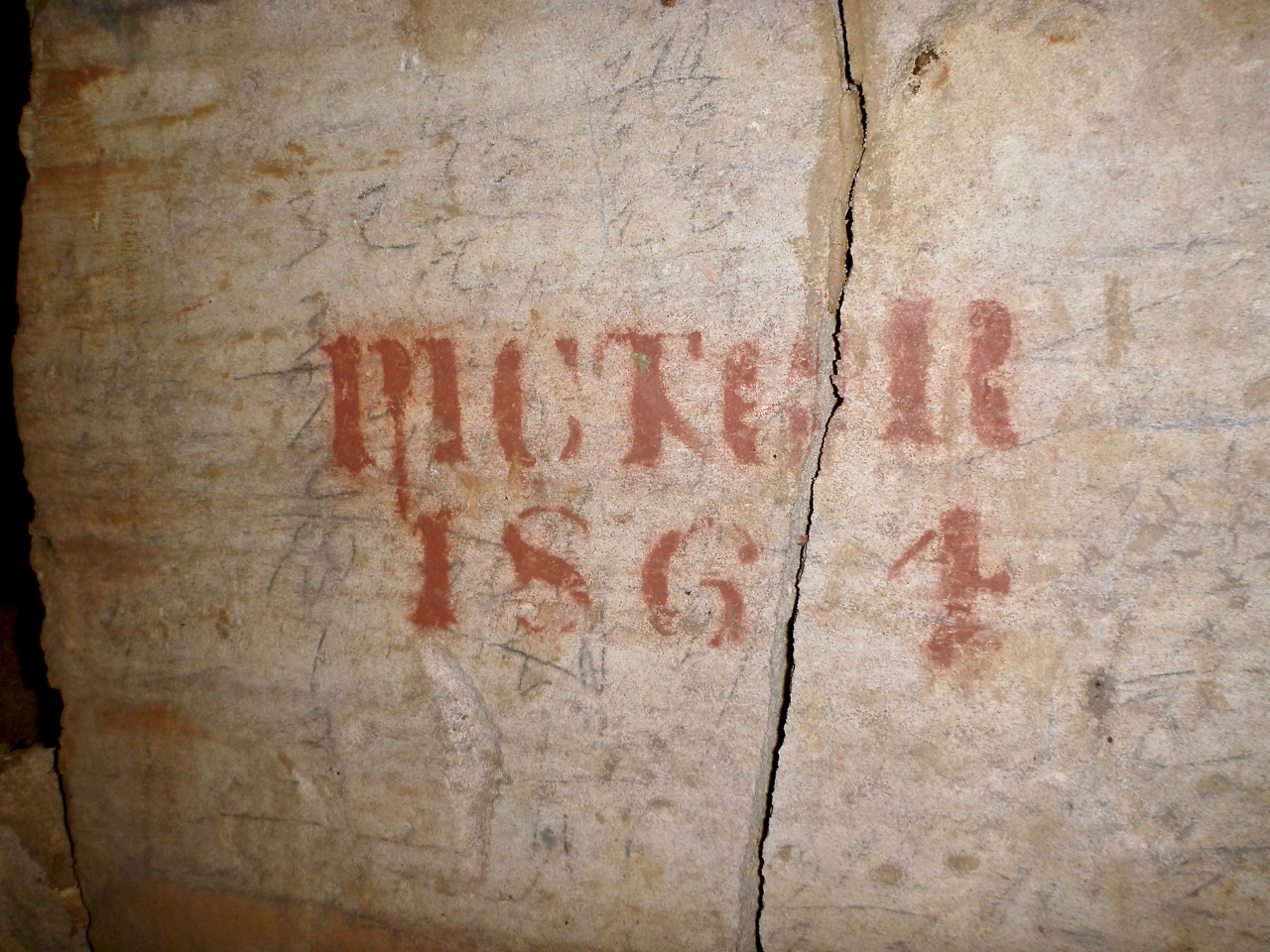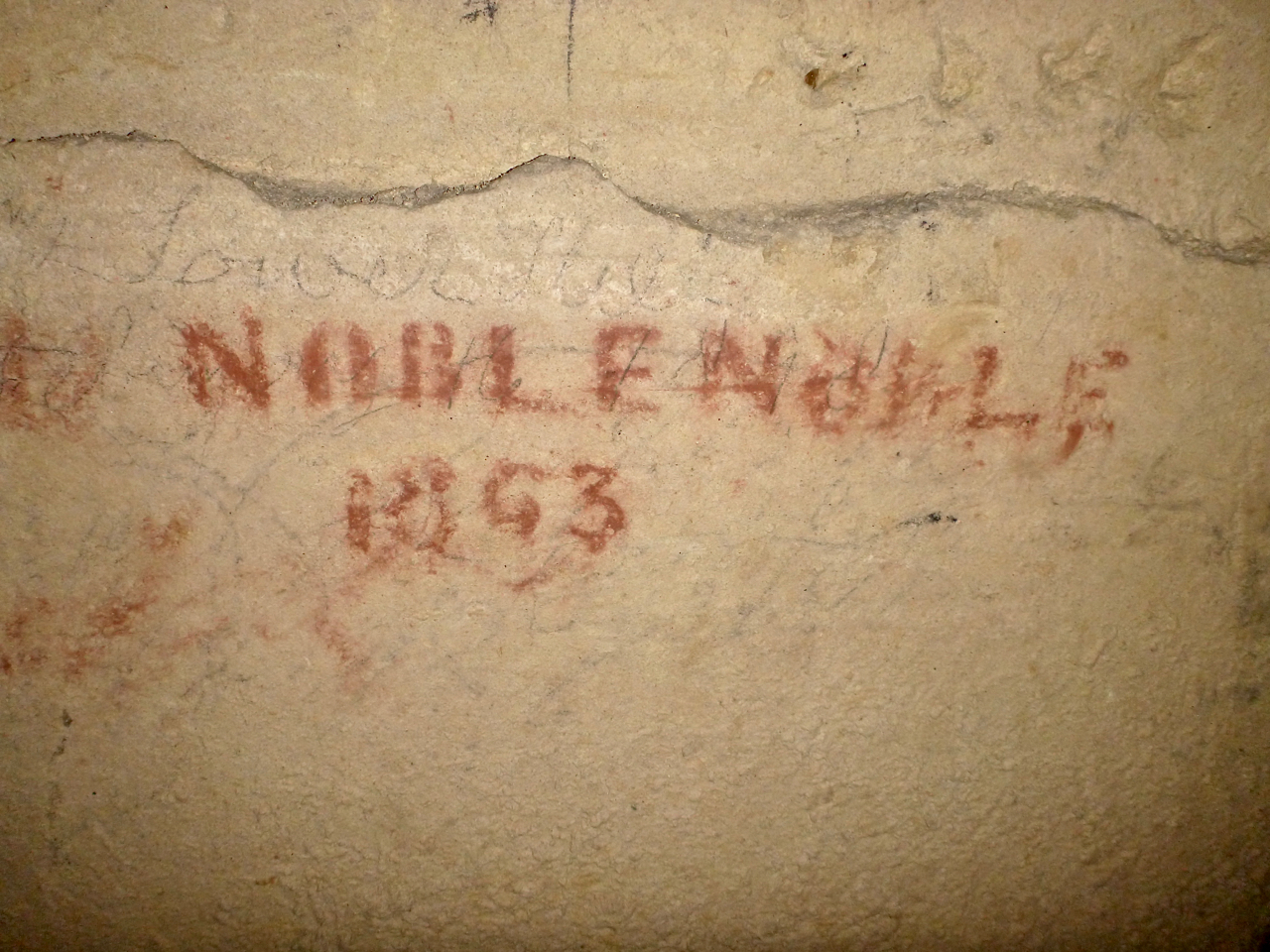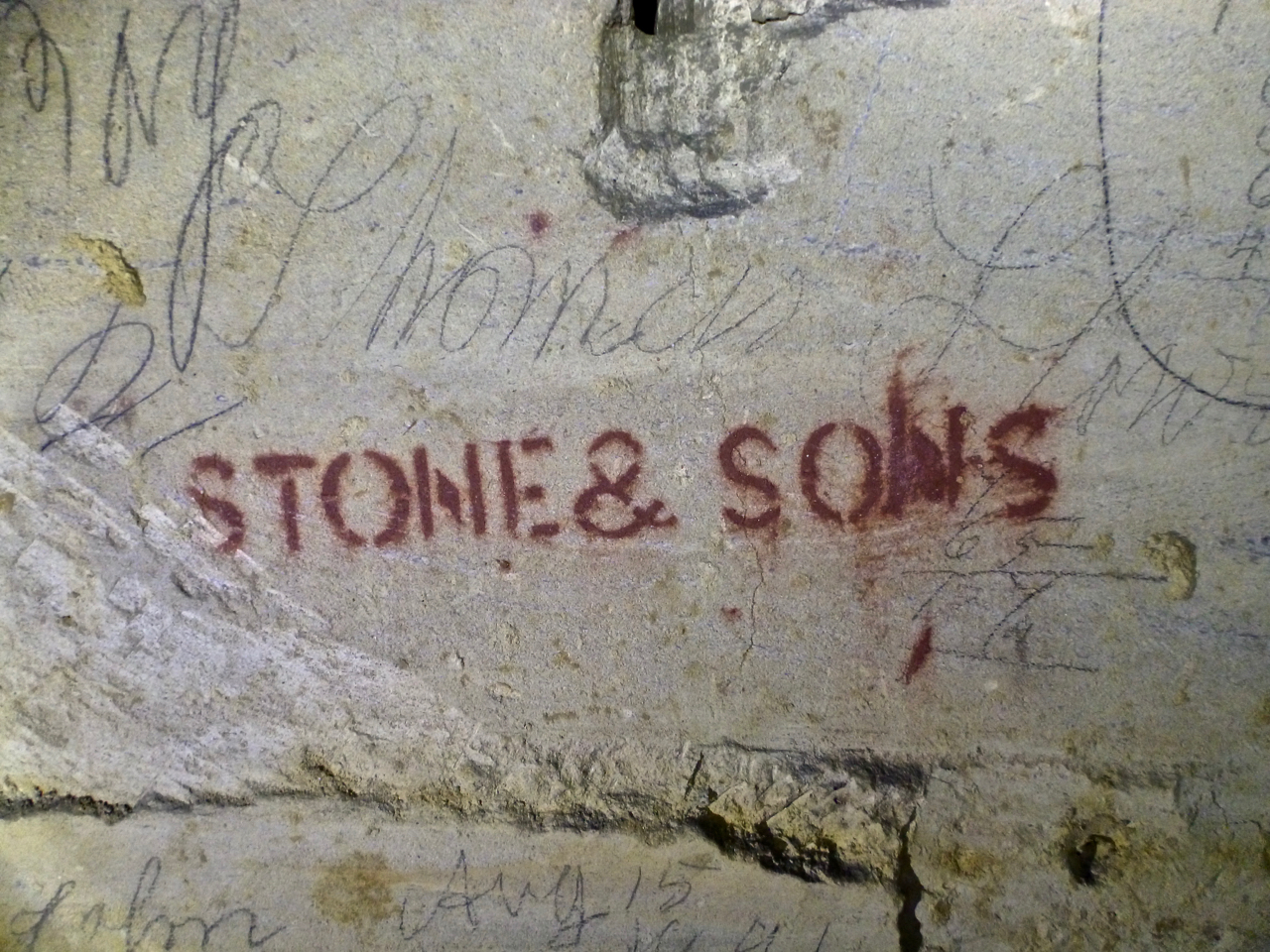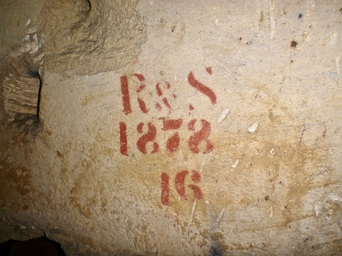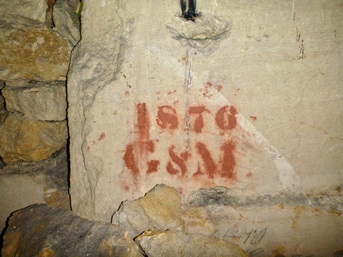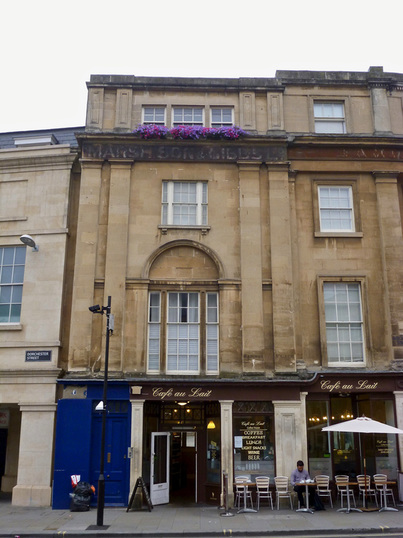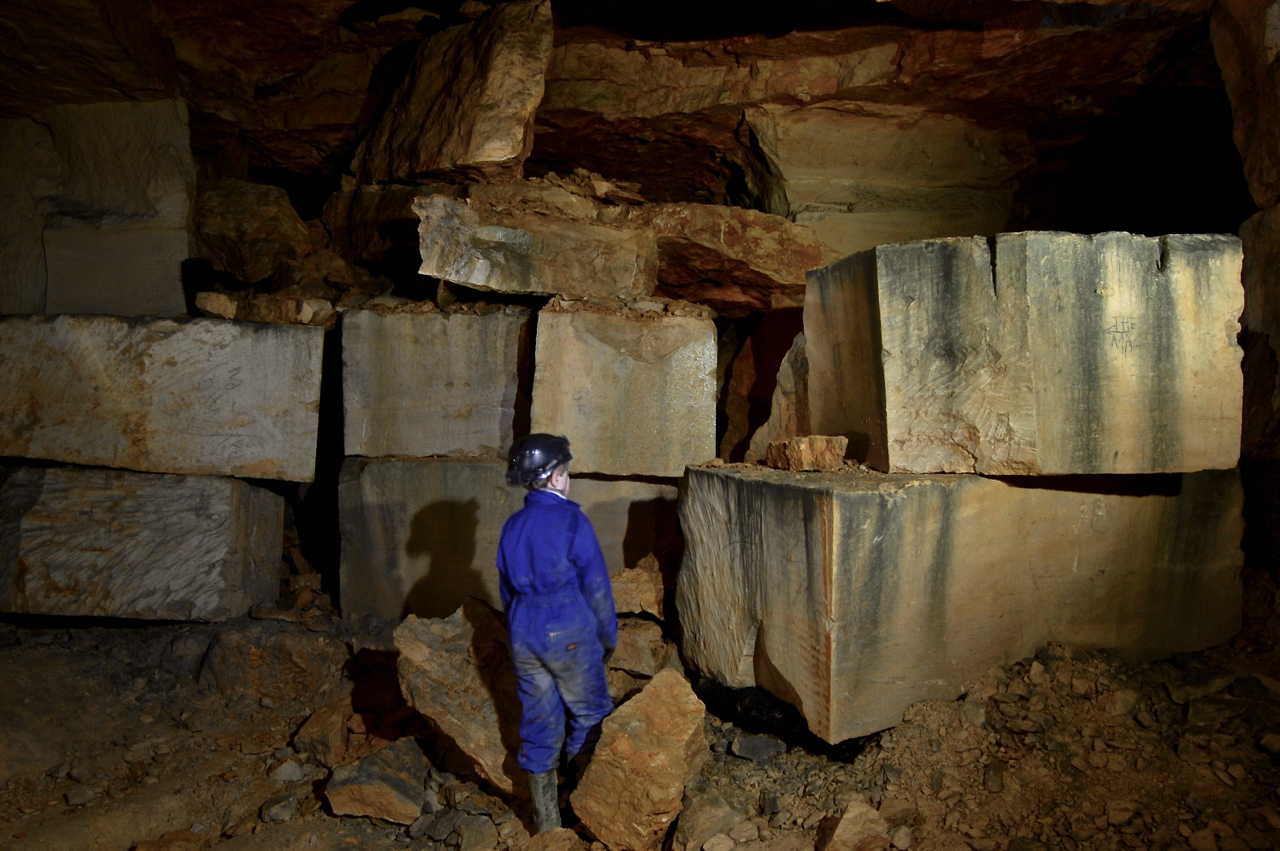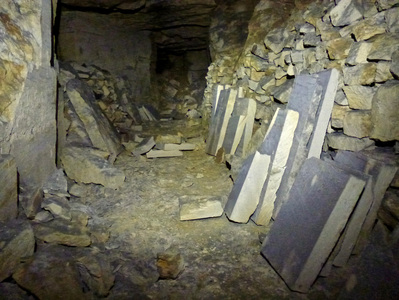Over-view of Box Underground Quarries Photos and text Mark Jenkinson January 2017
Box has been associated with fine quality stone for centuries, since at least Roman times with its grand villa built from locally quarried limestone. But it was in the 1800s that the quarrying of Box’s Bath Stone really took off, and its many separate underground workings in and around Box Hill expanded, eventually merging into what is now a vast labyrinth of passages.
While many of us colloquially refer to the underground workings as mines, the workers referred to them as quarries and to themselves as quarrymen. Miners mine minerals (like coal or metal ore); quarrymen quarry stone, even if it is underground.
The second half of the 19th century was Box’s heyday for quarrying; this activity declined significantly after the world wars and had ceased here completely by the end of the 1960s. Since that time, the unmaintained passages have lain dormant, slowly deteriorating. Instead of quarrymen, the only visitors have been cavers and other underground explorers, and also conservationists monitoring the important bat colonies that use parts of the quarry.
But the many decades of extensive quarrying have left their mark in terms of so much history that still remains. This article highlights a few such historical remnants. A short article cannot do justice to everything, but it can give a flavour at least.
While many of us colloquially refer to the underground workings as mines, the workers referred to them as quarries and to themselves as quarrymen. Miners mine minerals (like coal or metal ore); quarrymen quarry stone, even if it is underground.
The second half of the 19th century was Box’s heyday for quarrying; this activity declined significantly after the world wars and had ceased here completely by the end of the 1960s. Since that time, the unmaintained passages have lain dormant, slowly deteriorating. Instead of quarrymen, the only visitors have been cavers and other underground explorers, and also conservationists monitoring the important bat colonies that use parts of the quarry.
But the many decades of extensive quarrying have left their mark in terms of so much history that still remains. This article highlights a few such historical remnants. A short article cannot do justice to everything, but it can give a flavour at least.
Cranes
Box quarry is renowned for the collection of wooden cranes that remain deep within the underground system. Some of them appear to be in surprisingly good condition, belying their great age, which may be a hundred years or more; but they are of course weakening, and others have more visibly succumbed to the combination of wear, tear, and rotting timber.
Box quarry is renowned for the collection of wooden cranes that remain deep within the underground system. Some of them appear to be in surprisingly good condition, belying their great age, which may be a hundred years or more; but they are of course weakening, and others have more visibly succumbed to the combination of wear, tear, and rotting timber.
You can see how the cranes were operated from the computer-generated modelling that Mark and his son Ben produced to illustrate the Corsham Institute’s Bath Stone exhibition in autumn 2016 at Cranes at Work.
Ephemera
If Box’s cranes are at one end of the spectrum of the quarry’s remaining artefacts, in terms of size and apparent robustness at the other end of the spectrum are some of the most fragile remains. The label below left is for bottled beef from the Hogarth Australian Meat Preserving Company, Darling Downs. The picture below right shows label remains for files and rasps from George Barnsley & Sons, Sheffield.
If Box’s cranes are at one end of the spectrum of the quarry’s remaining artefacts, in terms of size and apparent robustness at the other end of the spectrum are some of the most fragile remains. The label below left is for bottled beef from the Hogarth Australian Meat Preserving Company, Darling Downs. The picture below right shows label remains for files and rasps from George Barnsley & Sons, Sheffield.
Below left is an Ogdens Cigarette card from 1902 for the music Hall performer, Childie Stuart, famous for her song Chase me Charlie, Charlie Chase me, Chase me Charlie, Do, which was released in 1899. She was a national star but it is doubtful that the quarrymen ever saw her perform. Instead they knew about her by collecting the card included in Ogden's Guinea Gold Cigarettes. Childie died in 1923. I found a pristine original of the 1902 Childie Stuart cigarette card shown below middle and right.
These remnants are understandably rare because the rough stone and high humidity provide a harsh environment for paper-based artefacts. This makes the few remains all the more precious when encountered in the dark passages.
Slightly more resilient artefacts include the quarrymen’s clay pipes. These are brittle, however, and are nearly always found as fragments; the best intact examples invariably tend to disappear from the quarry, which is a great shame.
Slightly more resilient artefacts include the quarrymen’s clay pipes. These are brittle, however, and are nearly always found as fragments; the best intact examples invariably tend to disappear from the quarry, which is a great shame.
Tools
Along with the cranes, all manner of tools were used by the quarrymen. Virtually the whole system - all but the very last headings - was picked or sawn out by hand. They had picks, irons, chips, wedges, files, and saws of every size and shape. A good selection may be seen on the walls of the Quarryman’s Arms pub.
Along with the cranes, all manner of tools were used by the quarrymen. Virtually the whole system - all but the very last headings - was picked or sawn out by hand. They had picks, irons, chips, wedges, files, and saws of every size and shape. A good selection may be seen on the walls of the Quarryman’s Arms pub.
Below left is a sketch on a quarry wall of a quarryman called Holder using one of the long saws (known as a frig bob) to cut a block. Frig bobs can be over 6 feet long. Water was a critical part of the quarrying process; for example stone-cutting saws needed lubricating and cart-pulling horses needed to drink. Several wells have been dug in the quarry passages to provide local water sources, below right.
Wooden Props and Tell-tales
If massive blocks of roof-bed weighing many tonnes are going to fall, not much will stop them, but wooden props were used to good effect to deflect or divert, and small wooden wedges were used in cracks in the roof to act as tell-tales; if they started to drop out, then it was a sign that something was on the move. Many wooden props remain, although they are so old and rotten that they retain little or no strength. The photograph below left shows some tell-tale wedges in the roof, still hanging on in there.
The tall wooden props below right have decayed back to their harder, inner heartwood; originally they would have been thicker, more uniform columns, but over the decades the softer outer wood just disintegrates to the floor.
If massive blocks of roof-bed weighing many tonnes are going to fall, not much will stop them, but wooden props were used to good effect to deflect or divert, and small wooden wedges were used in cracks in the roof to act as tell-tales; if they started to drop out, then it was a sign that something was on the move. Many wooden props remain, although they are so old and rotten that they retain little or no strength. The photograph below left shows some tell-tale wedges in the roof, still hanging on in there.
The tall wooden props below right have decayed back to their harder, inner heartwood; originally they would have been thicker, more uniform columns, but over the decades the softer outer wood just disintegrates to the floor.
Candles and Lamps
Tallow (animal fat) candles were first used for lighting; they were made in the factory on Quarry Hill. While the higher status stone masons were provided with candles to work by, quarrymen had to provide their own, so it was likely that they were frugal and therefore that their working conditions were even darker than we would imagine. Later, benzoline oil lamps were used. While some of these domed containers still remain, most have been squashed flat over the decades, by rocks or boots. Later still, carbide lamps were used, and there are large grey piles of spent carbide powder dotted around the quarry.
Tallow (animal fat) candles were first used for lighting; they were made in the factory on Quarry Hill. While the higher status stone masons were provided with candles to work by, quarrymen had to provide their own, so it was likely that they were frugal and therefore that their working conditions were even darker than we would imagine. Later, benzoline oil lamps were used. While some of these domed containers still remain, most have been squashed flat over the decades, by rocks or boots. Later still, carbide lamps were used, and there are large grey piles of spent carbide powder dotted around the quarry.
Cart Tracks
Stone from some earlier workings was only ever transported by carts, drawn by horse or donkey. The wheels of the carts left deep ruts in the floor that are still clearly evident (below left), and the sides of the carts often left scars in the walls. There were bays for carts where stone could be loaded from a higher level.
One of the most well-known animal workers in Box quarry is a donkey called Captain, who is depicted several times in sketches on the walls. The photograph below right of the sketch of Farmer Sheppard’s donkey, Captain, was taken by the light of a carbide lamp.
Stone from some earlier workings was only ever transported by carts, drawn by horse or donkey. The wheels of the carts left deep ruts in the floor that are still clearly evident (below left), and the sides of the carts often left scars in the walls. There were bays for carts where stone could be loaded from a higher level.
One of the most well-known animal workers in Box quarry is a donkey called Captain, who is depicted several times in sketches on the walls. The photograph below right of the sketch of Farmer Sheppard’s donkey, Captain, was taken by the light of a carbide lamp.
Rails and Sleepers
Later on, rails and sleepers were laid for trucks to run on, still pulled by horse. Later still, locomotive engines were used: steam and diesel. In many places there is a dark sooty band running along the centre line of the passage roof, left by the engines running along below.
There are remains of all these methods to be seen; below left, rails and junctions snaking off into different passages; and below right, two passages and their ceiling soot marks converging.
Later on, rails and sleepers were laid for trucks to run on, still pulled by horse. Later still, locomotive engines were used: steam and diesel. In many places there is a dark sooty band running along the centre line of the passage roof, left by the engines running along below.
There are remains of all these methods to be seen; below left, rails and junctions snaking off into different passages; and below right, two passages and their ceiling soot marks converging.
Below left is a quarryman's sketch of the steam loco at Box’s Clift Quarry entrance. It should be compared with the photograph from Clift Quarry Steam Loco as it is a very accurate contemporary sketch of the entrance workings (below right).
Boots
Quarrymen wore hobnailed leather boots. One or two fragile examples still remain (below left). If you look carefully, in some places you can find prints in the floor made by the quarrymen’s boots (below right).
Quarrymen wore hobnailed leather boots. One or two fragile examples still remain (below left). If you look carefully, in some places you can find prints in the floor made by the quarrymen’s boots (below right).
Graffiti
Most passage walls in the quarry are adorned with graffiti. Not modern painted graffiti of little or no artistic merit (although unfortunately there is plenty of that) but very old graffiti finely written and drawn in a charcoal-like material. Some of the graffiti is over 150 years old. Discussion of the graffiti really merits much more than a short paragraph. It represents a time capsule containing glimpses of what was on the minds of ordinary Box quarrymen from the late 1800s onwards. The graffiti includes: names, addresses, and dates; religious quotations; tallies of stone blocks and their dimensions; sketches and portraits; items of news and sports; lewd banter; and much more.
Remains of the fragile charcoal pencils that were used by the quarrymen can be hard to spot (below left). They were often used to calculate volumes of stone and the wages earned therefrom. Many tallies are of block dimensions and the corresponding volume. This large table, below right, shows groups of numbers that are summed. Each number is most likely a block volume (in cubic feet). I suspect that J, M, and W are the initials of quarrymen in the team. Quarrymen were paid on a piecework basis depending on the amount of usable stone they produced. It’s a shame about the modern and unnecessary white arrow marked over the top of this snapshot of history.
Most passage walls in the quarry are adorned with graffiti. Not modern painted graffiti of little or no artistic merit (although unfortunately there is plenty of that) but very old graffiti finely written and drawn in a charcoal-like material. Some of the graffiti is over 150 years old. Discussion of the graffiti really merits much more than a short paragraph. It represents a time capsule containing glimpses of what was on the minds of ordinary Box quarrymen from the late 1800s onwards. The graffiti includes: names, addresses, and dates; religious quotations; tallies of stone blocks and their dimensions; sketches and portraits; items of news and sports; lewd banter; and much more.
Remains of the fragile charcoal pencils that were used by the quarrymen can be hard to spot (below left). They were often used to calculate volumes of stone and the wages earned therefrom. Many tallies are of block dimensions and the corresponding volume. This large table, below right, shows groups of numbers that are summed. Each number is most likely a block volume (in cubic feet). I suspect that J, M, and W are the initials of quarrymen in the team. Quarrymen were paid on a piecework basis depending on the amount of usable stone they produced. It’s a shame about the modern and unnecessary white arrow marked over the top of this snapshot of history.
As an example of portraiture, Sam Ford was a quarryman who lived in Henley. He was born around 1829.
Quarry Companies
During most of the 19th century, different companies operated in different parts of Box quarry. It was only later that they merged into the Bath Stone Firms Ltd (later the Bath and Portland Stone Firms Ltd, and later still, Hanson plc). Evidence of some of the earlier companies remains, usually stencilled in red ochre paint.
During most of the 19th century, different companies operated in different parts of Box quarry. It was only later that they merged into the Bath Stone Firms Ltd (later the Bath and Portland Stone Firms Ltd, and later still, Hanson plc). Evidence of some of the earlier companies remains, usually stencilled in red ochre paint.
Stone Blocks
Of course, we must not forget the stone itself; the reason for all this hard labour. The photograph below left shows stocks of large blocks that were trapped by a roof fall. And smaller blocks known as ashlar were also cut, below right.
Of course, we must not forget the stone itself; the reason for all this hard labour. The photograph below left shows stocks of large blocks that were trapped by a roof fall. And smaller blocks known as ashlar were also cut, below right.
Caution
It goes without saying that disused mines and quarries should not be entered. They are dangerous and it is very easy to get very lost. Please do not attempt to enter.
It goes without saying that disused mines and quarries should not be entered. They are dangerous and it is very easy to get very lost. Please do not attempt to enter.
